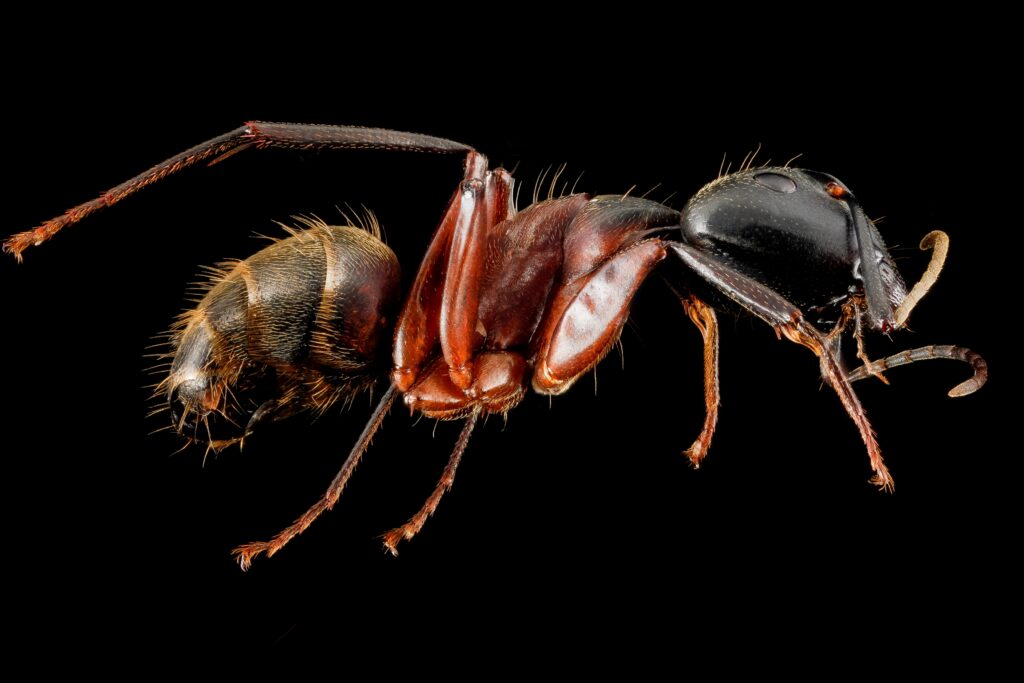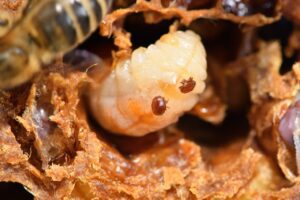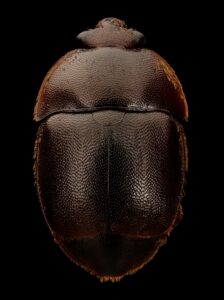Ants in beehives can pose a significant threat, often infiltrating colonies in search of food and shelter. For beekeepers, managing ant infestations and ant prevention is crucial to safeguarding the health and productivity of their bee colonies. Understanding the behavior of ants and implementing effective beekeeping pest control strategies can prevent structural damage to hives and ensure the well-being of honey bees. This guide explores common ant species that target beehives, their impact on bee colonies, and practical methods for ant prevention and management.

Table of Contents
1. Identifying Ant Species
Common Ant Species Found Near Beehives
Argentine Ants
Argentine ants (Linepithema humile) are small, light to dark brown ants that often invade beehives in search of food and shelter. They form extensive colonies and are known to disrupt hive operations by foraging on honey, larvae, and even adult bees. Controlling Argentine ants near beehives is crucial to prevent colony stress and potential collapse.
Carpenter Ants
Carpenter ants (Camponotus spp.) are larger ants typically black, red, or a combination of both. They don’t consume wood like termites but excavate it to build nests, which can weaken hive structures if they nest inside or near hives. Proper hive maintenance and keeping the area around hives clear of decaying wood and debris can help deter carpenter ants.
Pavement Ants
Pavement ants (Tetramorium spp.) are small, brown ants that nest in cracks and crevices near hives, particularly in soil or under stones. They feed on a variety of foods, including honey and dead insects, and can become a nuisance to beekeepers. Ensuring hive stands and surrounding areas are clean and free of food debris can discourage pavement ants from infesting beekeeping areas.
Characteristics of Ants You Might Encounter
Physical Appearance
Ants vary widely in size, color, and morphology depending on the species. They typically have a distinct three-segmented body (head, thorax, abdomen), antennae, and often have a stinger or acid gland. Identification often involves noting specific features like coloration, size, and the presence of spines or other unique characteristics.
Behavioral Traits
Ant behavior is highly organized, with roles such as workers, soldiers, and queens. They communicate using pheromones, using these chemicals to coordinate activities like foraging or defending the colony. Some species exhibit complex behaviors like farming aphids for honeydew or engaging in territorial disputes with other ant colonies.
Discover 6 Fascinating Ways Queen Bees Impact Hive Behavior

Nesting Habits
Ant nests can be found in diverse locations, from underground tunnels to inside wood structures or even in vegetation. They often construct elaborate tunnels and chambers within their nests, which can extend deep into the ground or create mounds on the surface. Nesting preferences vary widely among species, influenced by environmental factors and colony needs.
Foraging Behavior
Ants are efficient foragers, traveling in organized trails to food sources and back to their nests. They can forage over considerable distances from their colonies, with some species covering vast areas in search of food. Foraging patterns are influenced by factors such as food availability, environmental conditions, and pheromone trails left by other ants.
Diet and Feeding Patterns
Ants are omnivorous scavengers, feeding on a wide range of organic matter including dead insects, sugary liquids, plant secretions, and even small vertebrates. Some species have specialized diets, such as seed-harvesting ants that collect and store seeds in their nests. Feeding habits vary seasonally and are essential for sustaining colony growth and reproduction.
Ant Identification Tips for Beekeepers
- Size and Color: Note the size and coloration of the ants encountered near hives.
- Body Segmentation: Look for the three-segmented body structure typical of ants (head, thorax, abdomen).
- Antennae Characteristics: Observe the shape and length of the antennae.
- Presence of Wings: Determine if the ants have wings, which can indicate reproductive stages.
- Behavioral Traits: Watch for organized movement patterns and foraging behaviors.
- Nesting Habits: Identify where ants are nesting in relation to the beehives.
- Interaction with Bees: Note any interactions or conflicts with bees near the hives.
2. Sealing Entry Points for Ant Prevention
Identifying Vulnerable Entry Points
Identifying where ants might enter your beehive is crucial for effective prevention. Common entry points include cracks in hive boxes, gaps around hive stands, and openings in lids or bottoms where beehive pests can enter. Beehive ants can exploit even the smallest openings, so thorough inspection is key to locating these vulnerabilities.

Choosing Effective Sealants
Selecting the right sealant is essential for sealing entry points effectively. Opt for bee-safe materials such as silicone caulk or petroleum jelly, which ants can’t easily traverse. Ensure the sealant is applied neatly and covers the entire gap to prevent ants from finding alternative routes.
Addressing Environmental Factors
Environmental conditions can influence ant behavior and hive vulnerability. Keep vegetation around hives trimmed to reduce ant access points. Additionally, consider using ant deterrents like diatomaceous earth or cinnamon around hive stands to create barriers ants find challenging to cross.
These steps can help significantly reduce the risk of ants infiltrating your beehives and disrupting your colonies.
3. Natural Repellents and Barriers for Ants and Beehive Pests
Using Natural Repellents
Natural repellents like essential oils can effectively deter ants and other pests from beehives. Oils such as peppermint, tea tree, and citrus are known for their ant-repelling properties. To use them, dilute a few drops in water and spray around hive entrances and areas prone to ant activity. Reapply after rain or as needed to maintain effectiveness.
Installing Physical Barriers
Physical barriers can create obstacles that ants find difficult to navigate. Consider using sticky barriers or insect-proof mesh around hive stands and legs. These barriers physically prevent ants from climbing up and accessing the hive. Ensure the barriers are regularly inspected and maintained to remain effective.
Implementing Cultural Controls
Cultural controls involve practices that discourage ant activity near beehives. For instance, keeping the area around hives free from food sources and debris reduces ant attraction. Planting ant-repelling herbs like mint or lavender around hives can also create a natural deterrent. These plants emit scents that ants dislike, further discouraging them from approaching.
Enhancing Hive Hygiene
Maintaining hive hygiene is crucial in preventing ant infestations. Regularly clean hive components and remove debris that could attract ants. Ensure spilled honey or sugar syrup is promptly cleaned up to eliminate potential food sources. By keeping hives clean and free from attractants, beekeepers can reduce the likelihood of ant problems.
Using these natural repellents and barriers alongside good hive management practices can significantly mitigate ant infestations and protect bee colonies from potential harm.
4. Maintaining Hive Hygiene for Ant Prevention
Regular Cleaning Practices
Regularly clean hive components such as frames, inner covers, and bottom boards to remove debris and spilled honey that can attract ants. Use a hive tool to scrape off propolis and wax buildup, ensuring a clean and hygienic environment for bees.
Monitoring Moisture Levels
Ants are attracted to moisture, so it’s essential to monitor and manage humidity levels within the hive. Ensure adequate ventilation to prevent condensation, which can create ideal conditions for ants and other pests. Consider using moisture-absorbing materials like desiccants or absorbent pads if moisture levels are consistently high.
Securing Food Sources
Keep hive surroundings free from spilled honey, sugar syrup, and other food sources that may attract ants. Use entrance reducers to minimize access points for ants in beehives, especially during periods when food sources are abundant. This proactive measure helps beekeeping pest control, cleanliness and discouraging ant infestations.
5. Using Traps to Eliminate Beehive Ants
Types of Ant Traps
Ant traps for beehives typically include bait stations or sticky traps designed to attract and capture ants.
- Bait stations use insecticide-laced baits that ants carry back to their colony, effectively eliminating the entire nest over time.
- Sticky traps are placed strategically near hive entrances to catch ants as they attempt to access the hive, reducing their population around the beehive area.
Placement Strategies
Effective placement of ant traps is crucial for maximizing their impact. Traps should be positioned near hive entrances and along ant trails, where ants are most likely to travel. Placing traps on stable, flat surfaces ensures ants can easily access them while minimizing disturbance to the hive and bee activity.
Monitoring and Maintenance
Regular monitoring of ant traps is essential to gauge their effectiveness and replace them as needed. Check traps weekly to ensure they are still effective and free of debris. It’s also important to replenish bait stations with fresh bait and replace sticky traps when they become full or ineffective due to weather or debris accumulation.
Natural and DIY Trap Options
For beekeepers preferring natural or DIY solutions, there are several effective options. Diatomaceous earth, cinnamon powder, or citrus peels placed around hive entrances can deter ants without harming bees. DIY traps made from simple materials like glass jars with sugary baits or vinegar traps can also help reduce ant populations around beehives. Regular inspection and adjustment of these traps ensure ongoing protection for your bees without relying on chemicals.
6. Surrounding Area Management
Clearing Vegetation
Maintaining a clear zone around beehives helps reduce hiding places and nesting sites for ants. Regularly trim grass, shrubs, and weeds near the hive to minimize places where ants can establish colonies.
Removing Food Sources
Beehive ants are attracted to sugary substances, so eliminating potential food sources like spilled honey, sugar water, or fallen fruits around the hive area can help deter them from approaching the beehive.
Applying Natural Repellents
Using natural repellents for beehive pests such as vinegar or essential oils like peppermint around the hive can create a barrier that ants are less likely to cross. These substances disrupt ants’ scent trails and make the area less attractive to them.
Implementing Physical Barriers
Installing physical barriers like ant moats or sticky substances around the hive stand legs can prevent ants from climbing up to the hive entrance. These barriers physically block ants’ access to the hive, reducing the likelihood of infestation.
7. Monitoring and Early Intervention
Regular Hive Inspections
Performing regular inspections allows beekeepers to detect early signs of ant infestations and other beehive pests. By monitoring hive conditions and observing ant activity, beekeepers can intervene promptly before the infestation becomes severe.
Ant Prevention Measures
Implementing proactive ant prevention measures, such as sealing entry points, using ant traps, and maintaining hive hygiene, is crucial for effective pest control in beekeeping. By addressing potential vulnerabilities and minimizing attractants, beekeepers can reduce the risk of ant infestations.
Integrated Pest Management (IPM)
Utilizing integrated pest management strategies involves combining cultural, biological, and chemical control methods to manage pests sustainably. For ants and other beehive pests, IPM may include natural repellents, biological controls like beneficial insects, and judicious use of pesticides when necessary, ensuring minimal impact on bees and the environment.
Additional Resources
8 Common Beehive Pests and Effective Prevention Tips for Beekeepers
Understanding Wax Moths: 7 Key Facts Every Beekeeper Should Know
Agricultural Research Service Honey Bee Health
Conclusion
Effectively managing ant infestations around beehives is crucial for preserving bee colony health and productivity. By identifying ant species, sealing entry points, using natural repellents, and implementing effective traps, beekeepers can mitigate the risks posed by ants. Regular monitoring and prompt intervention are essential to maintaining a safe and pest-free environment for bees, supporting sustainable beekeeping practices and ensuring optimal honey production.


